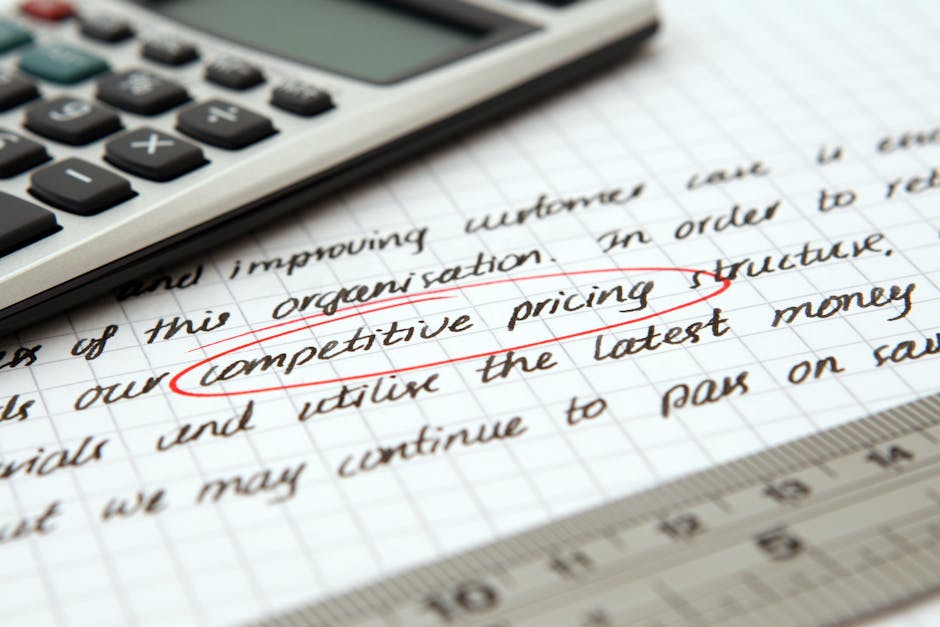Crafting Your SaaS’s Monthly Subscription Pricing Strategy
Crafting your SaaS’s monthly subscription pricing strategy is like sculpting a masterpiece – every detail matters, and the end result should be both captivating and valuable. As a SaaS company, determining the right pricing strategy is crucial for your success in a competitive market.
Understanding the intricacies of your customer segments, analysing your competitors’ pricing strategies, and implementing effective pricing experiments are all pivotal steps in crafting a pricing strategy that not only attracts customers but also sustains long-term revenue growth.
But how do you ensure that your pricing strategy is not just competitive, but also maximises value for your customers and profitability for your business?
Key Takeaways
- Understand your customer segments: Conduct market research to create detailed customer personas and identify their unique characteristics, behaviours, and pain points. This will help you tailor your pricing packages to meet their specific requirements.
- Analyse your competition: Conduct a comprehensive market analysis to understand the current pricing landscape and trends. Gain insights into pricing psychology and customer behaviour to identify potential pricing gaps or opportunities. Use this information to differentiate and innovate in your pricing model.
- Determine value-based pricing tiers: Segment your customers based on their needs and willingness to pay. Create pricing tiers with varying levels of features and conduct pricing research to understand customer perception of value. Regularly reassess and adjust your pricing tiers to aline with customer expectations.
- Implement effective pricing experiments: Use A/B testing to gather customer data and analyse their preferences and behaviour. Find pricing strategies that resonate with your audience and leverage pricing psychology to maximise revenue. Give customers the freedom to choose the best pricing model for them.
Understanding Your Customer Segments

To optimise your SaaS subscription pricing strategy, it’s essential to thoroughly understand your customer segments, ensuring that your pricing alines with their needs and value perceptions.
Start by creating detailed customer personas based on thorough market research. Understanding the unique characteristics, behaviours, and pain points of each customer segment allows you to tailor your pricing strategy to meet their specific requirements.
By leveraging market research data, you can identify the features and benefits that hold the most value for each customer segment, enabling you to offer pricing packages that resonate with their individual needs.
Customer-centric pricing strategies are crucial for SaaS businesses seeking to empower their customers with the freedom to choose the most suitable subscription plan.
Through a deep understanding of customer personas and market research insights, you can strategically design pricing tiers that aline with varying customer preferences.
This approach not only enhances customer satisfaction but also drives higher subscription rates and customer retention.
Analysing Competitive Pricing Strategies

By analysing the competitive pricing strategies employed by key players in your industry, you gain valuable insights that can inform the optimisation of your SaaS subscription pricing model. Conducting a comprehensive market analysis allows you to understand the current pricing landscape, identify pricing trends, and pinpoint potential pricing gaps or opportunities.
By examining your competitors’ pricing structures, you can gain a deeper understanding of pricing psychology and how it influences customer behaviour. This analysis can provide crucial data on how customers perceive value and make purchasing decisions, enabling you to strategically position your own pricing to maximise conversions and customer satisfaction.
Furthermore, understanding the competitive pricing strategies in your industry can help you identify potential areas for differentiation and innovation in your pricing model. By leveraging this knowledge, you can tailor your pricing strategy to meet the specific needs and preferences of your target customers, providing them with a sense of freedom and customisation.
Ultimately, a data-driven analysis of competitive pricing strategies empowers you to make informed decisions that drive the success of your SaaS product in the market.
Determining Value-Based Pricing Tiers

Understanding the competitive pricing strategies employed by key players in your industry provides a foundational framework for determining value-based pricing tiers that resonate with your target customers and drive optimal business outcomes. Value-based pricing is crucial for ensuring that your customers perceive the price of your SaaS subscription as fair in relation to the benefits they receive.
To determine the most effective value-based pricing tiers, consider the following strategic steps:
-
Customer Segmentation: Identify distinct customer segments based on their needs and willingness to pay, allowing you to offer tailored pricing tiers that aline with their specific requirements.
-
Feature Differentiation: Create pricing tiers that offer varying levels of features and functionality, allowing customers to choose the tier that best meets their needs while still feeling they have the freedom to upgrade as their requirements evolve.
-
Pricing Research: Conduct thorough pricing research to understand how your target customers perceive value and how they prioritise features, ultimately leading to a pricing structure that maximises customer satisfaction.
-
Continuous Iteration: Regularly reassess your value-based pricing tiers to ensure they remain alined with customer expectations and provide the freedom for customers to upgrade or downgrade as needed, ultimately driving customer satisfaction and loyalty.
Implementing Effective Pricing Experiments

Conduct A/B testing to assess customer response and gather valuable data for implementing effective pricing experiments that drive informed decision-making and maximise customer satisfaction. A/B testing involves presenting different pricing options to different groups of customers and analysing their responses. This data-driven approach allows you to understand customer preferences and behaviour, ultimately leading to pricing strategies that resonate with your audience. By experimenting with pricing models, you can leverage pricing psychology to find the sweet spot that offers value to your customers while maximising revenue for your SaaS product.
| Pricing Experiment | Customer Response | Impact on Satisfaction |
|---|---|---|
| Tiered Pricing | Higher conversion rates and increased revenue | Improved satisfaction due to perceived value |
| Freemium Model | Increased sign-ups and user engagement | Positive impact from free tier access |
| Dynamic Pricing | Varied customer reactions; potential for increased revenue | Enhanced satisfaction through personalised pricing |
Implementing effective pricing experiments not only allows you to fine-tune your pricing strategy but also demonstrates a customer-centric approach, giving your audience the freedom to choose the pricing model that best fits their needs.
Optimising for Long-Term Revenue Growth

To optimise for long-term revenue growth, you can leverage the insights gained from pricing experiments to strategically aline your SaaS subscription model with customer preferences and behaviour, ultimately driving sustained financial success. By focussing on pricing psychology and customer retention, you can ensure that your pricing strategy isn’t only appealing to potential customers but also encourages existing customers to stay loyal to your platform.
Here’s how to achieve long-term revenue growth:
-
Value-Based Pricing: Tailor your pricing tiers to reflect the varying needs and willingness to pay of different customer segments, providing a sense of freedom in choosing the most suitable option.
-
Data-Driven Iterations: Continuously analyse customer data and feedback to refine your pricing model, ensuring that it remains customer-centric and alined with evolving market trends.
-
Incentivised Upgrades: Encourage customers to upgrade by offering compelling incentives, such as additional features or exclusive access, creating a pathway to higher revenue per customer.
-
Personalised Retention Strategies: Implement personalised retention strategies based on individual customer behaviours and needs, fostering a sense of value and loyalty that contributes to long-term revenue growth.
Frequently Asked Questions
How Can I Effectively Communicate Price Changes to My Existing Customers Without Causing Dissatisfaction or Churn?
When communicating price changes to existing customers, focus on transparency and value. Provide clear explanations for the changes and emphasise the benefits they will receive. Offer options for feedback and reassurance to maintain satisfaction and reduce churn.
What Are Some Best Practises for Offering Discounts or Promotions Without Devaluing My Saas Product?
Looking at discount strategies, have you analysed your customer segments to tailor promotions effectively? By understanding customer value, behaviour, and preferences, you can offer targeted discounts that enhance loyalty without devaluing your SaaS product.
How Can I Identify and Address Potential Customer Objections to My Pricing Strategy?
When addressing objections to your pricing strategy, consider customer pushback and satisfaction. Communicate pricing clearly and demonstrate value. Use data-driven insights to adjust your strategy and provide flexibility, empowering customers to choose the best option for them.
What Are Some Key Metrics I Should Be Monitoring to Assess the Success of My Pricing Experiments?
To assess your pricing experiments, monitor customer retention and pricing elasticity. Track churn rates, customer lifetime value, and willingness to pay. Analyse these metrics to make data-driven decisions that prioritise customer satisfaction and business growth.
What Strategies Can I Use to Encourage Upsells and Cross-Sells Within My Saas Pricing Model?
To encourage upsells and cross-sells within your SaaS pricing model, consider implementing loyalty programmes and customer segmentation. By leveraging data-driven strategies, you can offer personalised incentives that drive customer engagement and boost revenue.
Conclusion
In conclusion, crafting a monthly subscription pricing strategy for your SAAS is like carefully constructing a fine-tuned instrument. Each component must be precisely calibrated to resonate with your customer segments, outperform competitors, and deliver maximum value.
By leveraging data-driven analysis, strategic pricing experiments, and a customer-centric approach, you can optimise for long-term revenue growth and ensure the success of your SAAS business.
Contact us to discuss our services now!